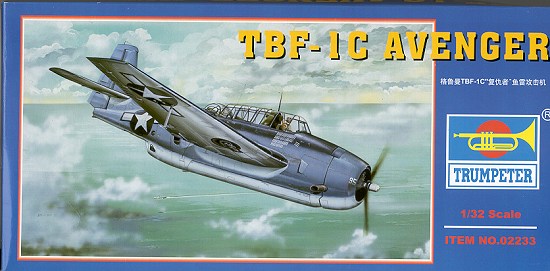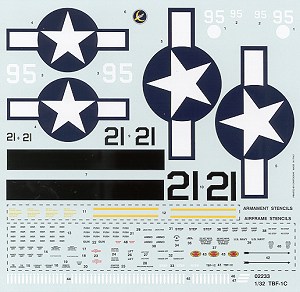
| KIT: | Trumpeter 1/32 TBF-1C Avenger |
| KIT #: | 02233 |
| PRICE: | $129.95 |
| DECALS: | Two options |
| REVIEWER: | Scott Van Aken |
| NOTES: | It's big, it's WWII USN and it has a ton of stuff in the box. |

| HISTORY |
I'll make the rash assumption that most readers will know about the Avenger in some form or another. The -1C variant differed from the -1 initial production aircraft by having the nose mounted .50 caliber gun removed and two of them placed in the wing (one each wing). The bomb bay was plumbed for a 275 gallon ferry tank and it could carry two 58 gallon tanks under each wing. Many of these planes were later modified to carry rockets under the wings or were fitted with ASB radar. This did not result in a redesignation of the airframe. This version was built both by Grumman as the TBF-1C and by Eastern Aircraft as the TBM-1C. The ever increasing weight of this version resulted in it being replaced on the production lines by the TBM-3 in mid 1944, Grumman shifting all Avenger production to Eastern Aircraft. Over 3,000 -1C versions were built by Grumman and Eastern Aircraft. Few made it into foreign air arms or into post war use.
| THE KIT |
Upon opening a huge box that puts even the 1/24 kits to shame, you are greeted by a lot of bags full of a lot of styrene, vinyl and photo etch. So much that showing all the sprues is impossible. Here is a link to a few of them as supplied by Stevens International. Just take it from me that the detailing on the outside is pretty much like every other Trumpeter kit with engraved everything; including the rivets. Since the last Trumpeter kit I built was festooned with ejector pin marks, I looked to see how this one fares. I was pleasantly surprised to see that this phenomenon has been reduced considerably and that perhaps some forethought has gone into the design of the sprues. I also noted that there was detailing on the inside of the fuselage in terms of wire and cable runs; things that were missing from previous builds.
This kit does use the same funky photo etched hinges with sections of wire to hold them together as was in the 109 so I'll undoubtedly figure some way to make these things fixed. P.E. is also used for the bomb bay door insides, some reinforcement plates and a few other bits like seat belts and shoulder harnesses. It also has vinyl tires for the main and tail wheels. A very pleasant surprise is a one-piece turret greenhouse. This will be a real bonus as filling and sanding seams on clear bits is generally a tough job.
The instructions are about what you'd
expect for a kit of this size and complexity. There are 28 pages that
comprise the 59 construction steps for building this monster of a kit.
While two of them are used for the parts diagram, all the rest are for
construction. It starts with building the engine, then moves to the
cockpit, then radio ope rator's
position. Next is the bomb bay and weapons from which you can have either a
fuel tank or a torpedo or a brace of 500 lb bombs. Then the bay is attached
to the interior/engine assemblies and you can work on the gunner's turret.
rator's
position. Next is the bomb bay and weapons from which you can have either a
fuel tank or a torpedo or a brace of 500 lb bombs. Then the bay is attached
to the interior/engine assemblies and you can work on the gunner's turret.
Next is the tail wheel assembly, tail hook assembly, bomb bay doors and putting all that plus the rudder in between the fuselage halves. It then goes to adding a bunch of bits to the fuselage before concentrating on doing the wings and tail planes. The wing assembly sequences seem to be divided as to folded or fixed wings. This kit uses the same miserable rod and p.e. hinges as other large Trumpeter kits and I'll be gluing my solid. Last construction parts are for the under wing rockets, the clear bits and final fiddly bits.
Markings are for two aircraft, both of them rather blah. One in Atlantic scheme of Dark Gull Grey over white for a VC-42 plane from the USS Bogue, and the other for a tri-color scheme aboard the USS Hornet with VT-2; both from 1944.The decal sheet is well printed and looks like it is quite usable. Only time will tell if that is true. I'm sure that there will be aftermarket sheets for this one coming out in the near future. I should mention that this kit only builds a -1C and not the later -3 version so your options may be somewhat limited in that respect. I should also mention that in my copy, there are no paint number references or any color names at all. Fortunately, WWII USN colors are relatively common so you can use the color information in any other kit to apply to this one.
| CONCLUSIONS |
Well, you asked for it and now you've got it. It will be a monster of a kit when finished and I'd be willing to bet that most builders will do it with folded wings so that it doesn't eat up a ton of display space. Regardless of which way you build it, it will be a most impressive model.
| REFERENCES |
Grumman Aircraft since 1929 by Rene Francillon, 1989, Naval Institute Press
Thanks to Stevens International for the review kit.
If you would like your product reviewed fairly and quickly by a site that has nearly 300,000 visitors a month, please contact me or see other details in the Note to Contributors.